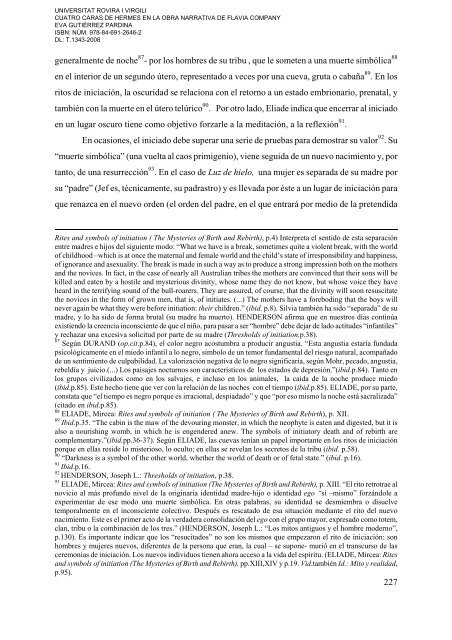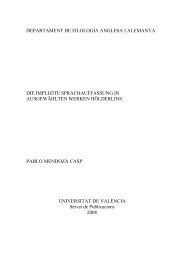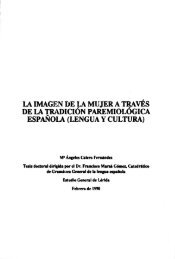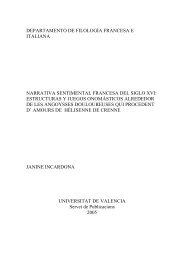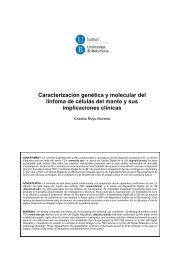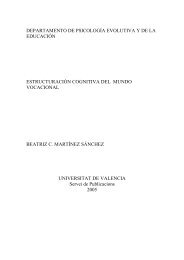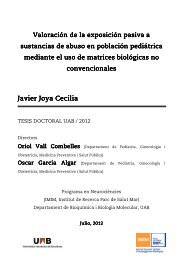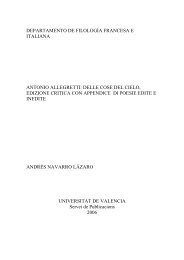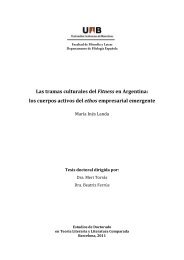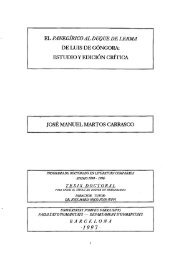You also want an ePaper? Increase the reach of your titles
YUMPU automatically turns print PDFs into web optimized ePapers that Google loves.
UNIVERSITAT ROVIRA I VIRGILI<br />
CUATRO CARAS <strong>DE</strong> HERMES EN LA OBRA NARRATIVA <strong>DE</strong> FLAVIA COMPANY<br />
EVA GUTIÉRREZ PARDINA<br />
ISBN: NÚM. 978-84-691-2646-2<br />
DL: T.1343-2008<br />
generalmente de noche 87 - por los hombres de su tribu , que le someten a una muerte simbólica 88<br />
en el interior de un segundo útero, representado a veces por una cueva, gruta o cabaña 89 . En los<br />
ritos de iniciación, la oscuridad se relaciona con el retorno a un estado embrionario, prenatal, y<br />
también con la muerte en el útero telúrico 90 . Por otro lado, Eliade indica que encerrar al iniciado<br />
en un lugar oscuro tiene como objetivo forzarle a la meditación, a la reflexión 91 .<br />
En ocasiones, el iniciado debe superar una serie de pruebas para demostrar su valor 92 . Su<br />
“muerte simbólica” (una vuelta al caos primigenio), viene seguida de un nuevo nacimiento y, por<br />
tanto, de una resurrección 93 . En el caso de Luz de hielo, una mujer es separada de su madre por<br />
su “padre” (Jef es, técnicamente, su padrastro) y es llevada por éste a un lugar de iniciación para<br />
que renazca en el nuevo orden (el orden del padre, en el que entrará por medio de la pretendida<br />
Rites and symbols of initiation ( The Mysteries of Birth and Rebirth), p.4) Interpreta el sentido de esta separación<br />
entre madres e hijos del siguiente modo: “What we have is a break, sometimes quite a violent break, with the world<br />
of childhood –which is at once the maternal and female world and the child’s state of irresponsibility and happiness,<br />
of ignorance and asexuality. The break is made in such a way as to produce a strong impression both on the mothers<br />
and the novices. In fact, in the case of nearly all Australian tribes the mothers are convinced that their sons will be<br />
killed and eaten by a hostile and mysterious divinity, whose name they do not know, but whose voice they have<br />
heard in the terrifying sound of the bull-roarers. They are assured, of course, that the divinity will soon resuscitate<br />
the novices in the form of grown men, that is, of initiates. (...) The mothers have a foreboding that the boys will<br />
never again be what they were before initiation: their children.” (ibid. p.8). Silvia también ha sido “separada” de su<br />
madre, y lo ha sido de forma brutal (su madre ha muerto). HEN<strong>DE</strong>RSON afirma que en nuestros días continúa<br />
existiendo la creencia inconsciente de que el niño, para pasar a ser “hombre” debe dejar de lado actitudes “infantiles”<br />
y rechazar una excesiva solicitud por parte de su madre (Thresholds of initiation,p.38).<br />
87<br />
Según DURAND (op.cit.p.84), el color negro acostumbra a producir angustia. “Esta angustia estaría fundada<br />
psicológicamente en el miedo infantil a lo negro, símbolo de un temor fundamental del riesgo natural, acompañado<br />
de un sentimiento de culpabilidad. La valorización negativa de lo negro significaría, según Mohr, pecado, angustia,<br />
rebeldía y juicio.(...) Los paisajes nocturnos son característicos de los estados de depresión.”(ibid.p.84). Tanto en<br />
los grupos civilizados como en los salvajes, e incluso en los animales, la caída de la noche produce miedo<br />
(ibid.p.85). Este hecho tiene que ver con la relación de las noches con el tiempo (ibid.p.85). ELIA<strong>DE</strong>, por su parte,<br />
constata que “el tiempo es negro porque es irracional, despiadado” y que “por eso mismo la noche está sacralizada”<br />
(citado en ibid.p.85).<br />
88<br />
ELIA<strong>DE</strong>, Mircea: Rites and symbols of initiation ( The Mysteries of Birth and Rebirth), p. XII.<br />
89<br />
Ibid.p.35. “The cabin is the maw of the devouring monster, in which the neophyte is eaten and digested, but it is<br />
also a nourishing womb, in which he is engendered anew. The symbols of initiatory death and of rebirth are<br />
complementary.”(ibid.pp.36-37). Según ELIA<strong>DE</strong>, las cuevas tenían un papel importante en los ritos de iniciación<br />
porque en ellas reside lo misterioso, lo oculto; en ellas se revelan los secretos de la tribu (ibid. p.58).<br />
90<br />
“Darkness is a symbol of the other world, whether the world of death or of fetal state.” (ibid. p.16).<br />
91<br />
Ibid.p.16.<br />
92<br />
HEN<strong>DE</strong>RSON, Joseph L.: Thresholds of initiation, p.38.<br />
93<br />
ELIA<strong>DE</strong>, Mircea: Rites and symbols of initiation (The Mysteries of Birth and Rebirth), p. XIII. “El rito retrotrae al<br />
novicio al más profundo nivel de la originaria identidad madre-hijo o identidad ego “sí –mismo” forzándole a<br />
experimentar de ese modo una muerte simbólica. En otras palabras, su identidad se desmiembra o disuelve<br />
temporalmente en el inconsciente colectivo. Después es rescatado de esa situación mediante el rito del nuevo<br />
nacimiento. Este es el primer acto de la verdadera consolidación del ego con el grupo mayor, expresado como totem,<br />
clan, tribu o la combinación de los tres.” (HEN<strong>DE</strong>RSON, Joseph L.: “Los mitos antiguos y el hombre moderno”,<br />
p.130). Es importante indicar que los “resucitados” no son los mismos que empezaron el rito de iniciación: son<br />
hombres y mujeres nuevos, diferentes de la persona que eran, la cual – se supone- murió en el transcurso de las<br />
ceremonias de iniciación. Los nuevos individuos tienen ahora acceso a la vida del espíritu. (ELIA<strong>DE</strong>, Mircea: Rites<br />
and symbols of initiation (The Mysteries of Birth and Rebirth), pp.XIII,XIV y p.19. Vid.también Id.: Mito y realidad,<br />
p.95).<br />
227


